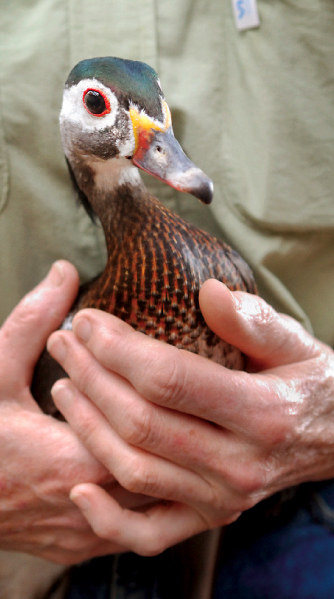Ask Melanie Piazza about her job as director of animal care at WildCare, and you might just hear the tale about a spooked ringtail whose nose got her in trouble and the big hearts that got her out.
A repeat offender at a garbage can, the ringtail, a member of the raccoon family, had frustrated a homeowner in Lake County who finally trapped her for the last time and gave her to an acquaintance who wanted her as a pet.
After the cage containing said ringtail was loaded into his car, she escaped, diving under the dashboard, where she hid all while the driver made a quick detour to a local mechanic, who dismantled the dashboard. When the mechanic grabbed her, she bit him and eventually was corralled back into her cage. Soon the ringtail was headed for WildCare, the wildlife rehabilitation center in San Rafael.
Over the next 24 hours, there was a flurry of phone calls. Everyone involved in the incident wanted to save her—the mechanic even volunteered to have a rabies shot—but Marin County’s Department of Health insisted she be killed and tested for rabies.
“It wasn’t her fault; it was self-defense,” insists Piazza. “I made a lot of enemies that day, but I went over their heads and called the state veterinarian. The ringtail was already under anesthesia being prepared for euthanasia when we got the return call and it was just like getting a reprieve from the governor.” Three months later, the ringtail was released back into the wild in Lake County.
That story had a happy ending, but other, more heartbreaking endings occur that are preventable, and that’s why, for WildCare, nature education is as important as saving lives.
 Open seven days a week, the center bustles with the efforts of more than 50 to 200 volunteers, who work alongside 13 full-time staffers in tight quarters each day tending up to 4,000 animal patients each year. During that time span, more than 40,000 children and adults will either visit the on-site museum, watch birds being fed in the small courtyard pool (at 12:30 p.m. and 4:30 p.m.) or participate in a WildCare field trip, camp or nature class. Operators answering the free hotline annually field thousands of questions about creatures, and the Wildlife Solutions Service program helps homeowners resolve issues with their wild neighbors.
Open seven days a week, the center bustles with the efforts of more than 50 to 200 volunteers, who work alongside 13 full-time staffers in tight quarters each day tending up to 4,000 animal patients each year. During that time span, more than 40,000 children and adults will either visit the on-site museum, watch birds being fed in the small courtyard pool (at 12:30 p.m. and 4:30 p.m.) or participate in a WildCare field trip, camp or nature class. Operators answering the free hotline annually field thousands of questions about creatures, and the Wildlife Solutions Service program helps homeowners resolve issues with their wild neighbors.
“We’re leading the way to show people how to coexist with and do the right thing for wildlife,” executive director Karen Wilson says. “All of our programs involve practical, respectful and humane solutions.”
And it’s all done from a small, cobbled-together space in an aging former church community center on less than an acre on Albert Park Lane. In the courtyard, the pool for resident waterbirds (Sausalito’s renowned Marine Mammal Center was launched here) shares space with cages for other permanent residents and popular “wildlife ambassadors” such as Vlad the turkey vulture and Willow the wood duck. The museum doubles as a staff conference room. In the back, three “wards” are stacked with towel-covered baskets and cages holding wildlife patients. There’s a cramped medical room with a tiny exam table for small animals, while procedures on larger animals that can’t be secured pro bono in a veterinarian’s office are performed on the floor. “In a perfect world, we’d have three bigger med rooms with state-of-the-art equipment,” Wilson says. “When it gets busy, we get backed up here.”
It’s especially busy in summer during the peak baby bird season; baskets containing birds are on every surface in the bird room and timers are set for feedings every 15 minutes from sunrise to sunset. “It’s a cacophony of sounds with all the chirping and timers going off,” Wilson says.
Baby mammals — opossums, raccoons, rabbits and squirrels — are sent to foster homes to be fed every two to four hours. Wilson’s on the squirrel team. “There are no nine-to-five jobs here,” she notes with a laugh. All patients “get the best care,” she adds, “but there’s a great need for a bigger hospital and a real demand from parents and teachers to have more interactive exhibits.” A “baby cam” for online viewing of the youngest patients is also on the wish list.
For now, that list may have to wait. As the primary triage center for the Cosco Busan oil spill, WildCare spent $120,000 (and will probably only see $10,000 in reimbursement) treating nearly 600 oiled birds before transporting them more than an hour north to the Cordelia International Bird Research and Rescue Center for washing. “If we had a larger facility, we could have washed them here and saved them the commute,” Wilson says. Until then, Wilson will make sure the building is patched up, the wild patients receive good care, the public is served and workers are poised for the next emergency.
“This place is really run on the dedication of the incredible staff and volunteers and the visionary board of directors,” she reflects. “Everybody here is keeping it together out of sheer willpower, and I’m just determined to bring it together and push it ahead.”
WildCare in San Rafael hotline: 415.456.SAVE; wildcarebayarea.org


